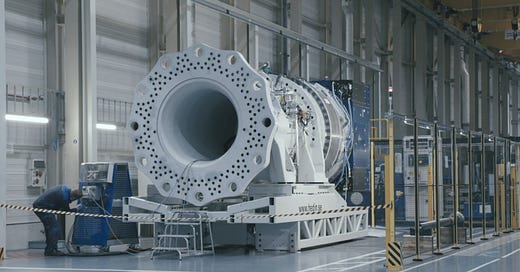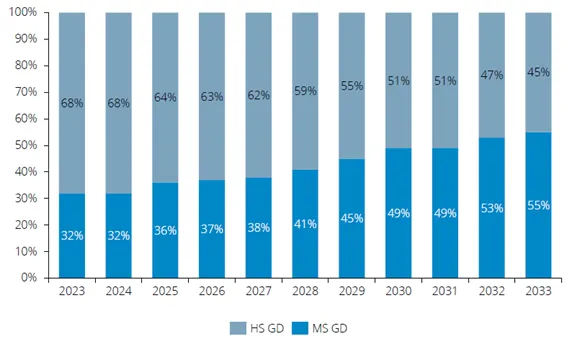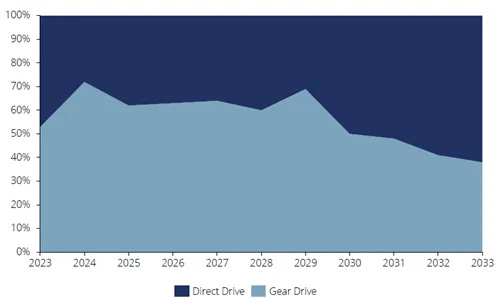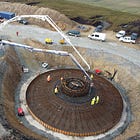Windguest #3 – Types of wind turbine drivetrains
Wind turbine manufacturers have explored multiple drivetrain configurations. Today, different architectures coexist, each with its own strengths and limitations.
Hello everyone and welcome to a new issue of Windletter. I'm Sergio Fernández Munguía (@Sergio_FerMun) and here we discuss the latest news in the wind power sector from a different perspective. If you're not subscribed to the newsletter, you can do so here.
Windletter is sponsored by:
🔹 Tetrace. Reference provider of O&M services, engineering, supervision, and spare parts in the renewable energy market. More information here.
🔹 RenerCycle. Development and commercialization of specialized circular economy solutions and services for renewable energies. More information here.
🔹 Nabrawind. Design, development, manufacturing, and commercialization of advanced wind technologies. More information here.
Windletter está disponible en español aquí
As you already know, from time to time we bring guest contributors to Windletter who introduce new topics explained by experts in the field. For a while now, the articles written by guest authors have been grouped under the #Windguest section. If you believe you have something interesting to share, feel free to contact me by replying to this email or via LinkedIn.
Today’s article has been written in collaboration with Pablo Carazo Morales. Pablo is a Mechanical Engineer with over 10 years of experience in the onshore and offshore wind sector, having worked on both the manufacturer and developer sides. He also collaborates with Windtechs, a wind turbine technology Market Intelligence company. You can follow them on LinkedIn or visit their website here.
I’ll leave you with him.
⚙️ Types of wind turbine drivetrains
Over the past few decades, wind turbine manufacturers have explored multiple drivetrain configurations, shifting from one to another as a result of a combination of technological innovations and operational experience.
The drivetrain includes all mechanical and electrical components between the rotor (hub and blades) and the generator. Its main function is to adapt the rotor’s rotational speed to that of the generator, if such adaptation is needed, as we will see below.
After 40 years of evolution, the market has reduced the number of drivetrain options, but it has not converged on a single solution. Today, several architectures coexist, each with its own strengths, limitations, and optimal usage contexts.
Drivetrain classification
Depending on the generator’s rotational speed, drivetrains are classified into three main categories:
High Speed (HS): These use a gearbox with 3 or 4 stages to increase the rotor speed to values above 1,000 rpm at the generator.
Medium Speed (MS): These use a simpler gearbox with 1 or 2 stages, reaching intermediate speeds between 100 and 600 rpm.
Direct Drive (DD): These eliminate the gearbox. The rotor is connected directly to the generator, which rotates at the same speed, typically between 8 and 15 rpm depending on rotor size (generally, the larger the rotor, the lower the speed).
Over time, four main drivetrain types have come to dominate the market.
DFIG (Double Feed Induction Generator) + Partial Converter. This is a high-speed drivetrain. It is the configuration used by Nordex, Siemens Gamesa (onshore, with ex-Gamesa technology), and General Electric (onshore). It corresponds to Type C in the image below. The development of DFIG technology undoubtedly marked a turning point in the industry, one that still resonates today.
SCIG (Squirrel Cage Induction Generator) + Full Converter. This is also an asynchronous generator type, like the DFIG, but without slip rings. Vestas has used this type of generator in its platforms up to 4 MW, which have been highly successful, especially the V150-4.X. It corresponds to Type F in the image below.
Medium Speed PMSG (Permanent Magnet Synchronous Generator) + Full converter. Also known, particularly by Chinese manufacturers, as a hybrid drive. This is a medium-speed drivetrain. It corresponds to Type C in the image below. It is the drivetrain used by Vestas in its EnVentus platform.
Direct Drive PMSG + Full converter. This is a low-speed drivetrain without a gearbox. It corresponds to Type D in the image below. It is the drivetrain used by Enercon (which also includes the EESG configuration in its portfolio), Siemens Gamesa (offshore), and General Electric (offshore).
Historically, high-speed drivetrains were the preferred option among manufacturers. However, in recent years, a transition towards medium-speed drivetrains can be observed in both onshore and offshore segments, adopted by many OEMs, both Western (such as Vestas) and Chinese (such as Goldwind or Mingyang).
The shift from high-speed to medium-speed drivetrains is not driven by a single reason but by a combination of technical and operational factors that have gained relevance in recent years:
On one hand, DFIG generators, typical of high-speed drivetrains, use slip rings to connect the rotor to the partial converter. These components are subject to significant wear and require frequent maintenance interventions, increasing O&M tasks.
On the other hand, although the DFIG with a partial converter represents a more cost-effective solution compared to the PMSG with full converter, its performance is inferior in terms of grid code compliance. In markets with strict requirements in this area, such as Australia, this limitation can be decisive.
Moreover, as turbine size and power ratings increase, high-speed gearboxes become increasingly complex. That said, this has not prevented Sany from scaling its DFIG wind turbines up to 15 MW.
The case of Vestas is particularly striking, having adopted different drivetrain configurations throughout its history and currently maintaining several of them in its portfolio:
Discontinued: high-speed drivetrains with DFIG + Partial Converter architecture (V5X, V80, V90…)
2MW Platform: high-speed drivetrains with DFIG + Partial Converter architecture (V110-2.0 MW, V120-2.2 MW)
4MW Platform: high-speed drivetrains with SCIG + Full Converter architecture (V117, V126, V136, V150, V163 in the 3.45 to 4.5 MW range)
EnVentus Platform: medium-speed drivetrains with PMSG + Full Converter architecture (V150, V162, V172 in the 6 to 7.2 MW range)
Other manufacturers like Siemens Gamesa also have a wide variety in their portfolios. In the onshore segment, DFIG machines dominate sales, but Direct Drive options are also available for certain markets such as Japan, as well as asynchronous generators with full converters for the U.S. market. You can view Siemens Gamesa’s onshore portfolio here.
In the onshore segment, medium-speed drivetrains offer several advantages over the traditional high-speed configuration:
The high-speed stage of the gearbox is eliminated. This is typically the most costly in terms of OPEX.
O&M activities are reduced by using a PMG (Permanent Magnet Synchronous Generator) instead of the classic DFIG (Doubly-Fed Induction Generator).
Grid code compliance and performance during voltage dips are improved.
The main drawback, though not negligible, is that this is a higher CAPEX solution (PMG and full converter) compared to high-speed (HS) with DFIG.
In the following graph, we can see the projected growth of medium-speed drivetrains in the coming years.
In offshore wind, there is a balance between direct drive solutions (dominated by SGRE due to its strong offshore presence) and medium-speed drivetrains (Vestas, Mingyang…), while high-speed solutions with gearboxes are now residual.
The main advantages of medium-speed drivetrains are:
Reduction in the amount of permanent magnets and rare earth materials (by a factor of 1:4).
Reduction in generator size and weight.
However, the main drawback is that offshore has always prioritized reliability over CAPEX. Introducing a gearbox, which is a component with O&M requirements, can lead to higher OPEX (due to the need for installation vessels or jack-up vessels, and offshore personnel costs).
In conclusion, we can affirm that the medium-speed drivetrain configuration is here to stay, both onshore and offshore, driven by top-tier manufacturers such as Vestas, Goldwind, and Mingyang.
Others, such as SGRE, Nordex, or GE, continue to rely on high-speed technology in the onshore segment or on direct drive in the case of SGRE offshore, and they are expected to maintain these approaches for many years to come.
Read other guest contributions:
Thank you very much for reading Windletter and many thanks to Tetrace, RenerCycle and Nabrawind our main sponsors, for making it possible. If you liked it:
Give it a ❤️
Share it on WhatsApp with this link
And if you feel like it, recommend Windletter to help me grow 🚀
See you next time!
Disclaimer: The opinions presented in Windletter are mine and do not necessarily reflect the views of my employer.
















